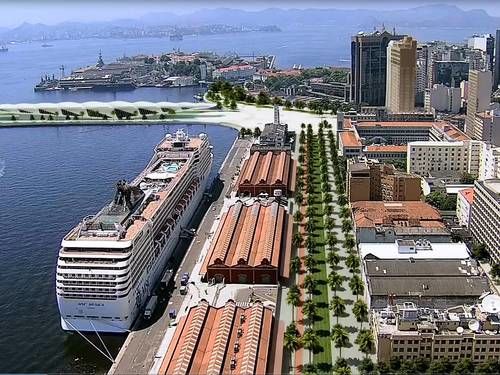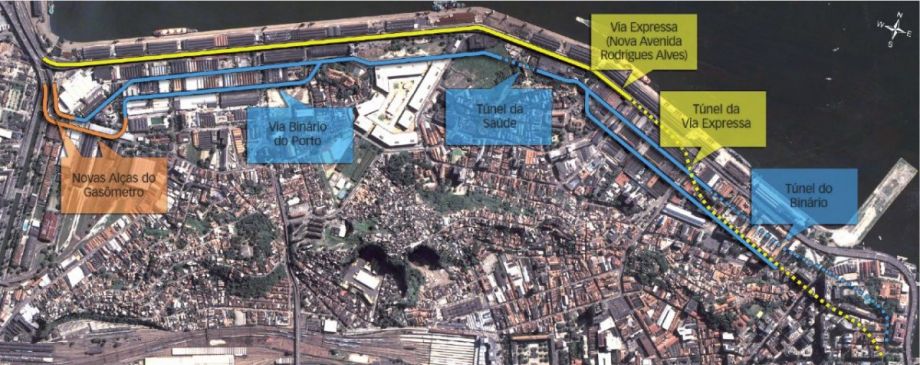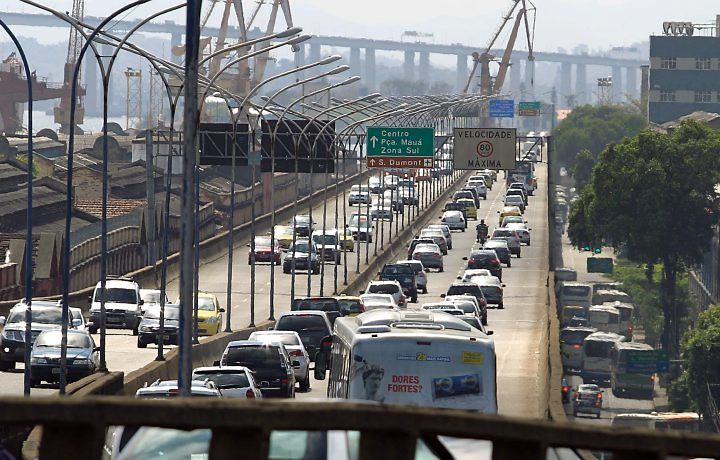On November 24, a half-century of tropical traffic jams went up in a cloud of carefully controlled smoke as Rio de Janeiro demolished a one-kilometer stretch of the Perimetral Elevated Highway. In a month that saw two workers die when a crane fell off the roof of a new São Paulo soccer stadium that will host the opening game of next year’s World Cup, the accident-free implosion allowed Rio Mayor Eduardo Paes to brag a few days later that the International Olympic Committee (IOC) was “impressed” with the video of the demolition, which made it look more like a Jason Bourne thriller than a civil engineering project.
Knocking down waterfront highways is all the rage, but not all highway demolitions are created equal. They run the gamut from the good (San Francisco’s Embarcadero, torn down in 1991 to create a complete streets wonderland) to the debatable (Seattle’s Alaskan Way Viaduct, which is being replaced with a high-capacity tunnel that will ultimately carry even more cars than the original structure).
Rio certainly has one eye on America, but also on its neighbors. There is some keeping-up-with-the-Joneses going on here, as cities like Medellín and Bogotá are showered with praise for their urban redesign efforts. In Bogotá, urbanist darling and former mayor Enrique Peñalosa nixed plans for an Inner Ring Expressway in favor of a bike and pedestrian corridor. But the real model is Rio’s Olympic older sibling – in preparation for the 1992 Summer Olympics, Barcelona removed an oceanfront rail line to make way for the city’s now iconic Barceloneta beachfront.
Indeed, although the locus of Olympic activity in Rio will be on the other side of the city, the simultaneous revitalization of the downtown port area has been subsumed into the Olympic morass. In part this is because the IOC demanded that some degree of infrastructure be headquartered in the historic city center, rather than just in the suburban expanses of the distant Barra da Tijuca district, where the Olympic Village will be located (much to the dismay of the New York Times‘ architecture critic). Known as the Marvelous Port – a play off of Rio’s nickname, the Marvelous City – the project clocks in at a 2012 budget of 7.6 billion Brazilian reais ($3.3 billion USD).
Thus, the Referees and Media Village will be located in the Olympic Port, a complex just to the west of the Marvelous Port, the largest public-private partnership in Brazil. By putting an Olympic sheen on the Marvelous Port project, an urban waterfront revitalization scheme akin to London’s Docklands or Buenos Aires’ Puerto Madero – which has received its share of criticism for sprucing up a scruffy neighborhood at the expense of long-time poorer residents – the city can justify the accelerated timeline.
Video of the demolition, via YouTube
But whether the project is even justified on its merits is another question. In an interview after a December 2 lecture on “Rio de Janeiro’s Olympian Troubles” at Columbia University’s Graduate School of Architecture, Planning, and Preservation, Christopher Gaffney, Visiting Professor of Urbanism at the Federal Fluminense University, called the decision to knock down the Perimetral “a historical mistake to correct a historical mistake.” He pointed to collusion between political and business leaders in the city’s bulging portfolio of urban redevelopment projects, with the ticking Olympic clock serving as an excuse for no-bid contracts and other shady dealings.
The Olympic deadline is why, while some cities have dithered about what to do with the real estate opened up once an elevated highway becomes urban legend, Rio is doing just the opposite, with public works and private real estate outpacing the Perimetral’s demolition and subsequent rebirth as an underground tunnel. In March, the Rio Museum of Art (MAR in Portuguese, which also means “sea”) opened to the public, offering a breathtaking view of Guanabara Bay from its rooftop terrace – an even better vantage point than the admittedly picturesque view from the former highway itself, which this author had enjoyed on occasional Sundays in Rio when the road was closed to car traffic for bike races. The Santiago Calatrava-designed Museum of Tomorrow, still very much under construction, will also benefit from the highway demolition. And as early as 2010, a series of abandoned warehouses separated from the rest of downtown by the Perimetral were repurposed for the World Urban Forum and, later, Rio Fashion Week.
The accelerated pace has made for a tough job when it comes to the gargantuan traffic rerouting effort. The highway’s closure was delayed multiple times this fall over howls that the city had not clearly explained the alternatives. Hundreds of thousands of cars pour over the Rio-Niterói bridge that crosses the bay or ride into downtown on the endless bus flotillas from the working class North Zone, all of which dump drivers directly onto the Perimetral.
Ronaldo Balassiano, Associate Professor of Transportation Planning at COPPE, the graduate engineering school of the Federal University of Rio de Janeiro, defends the city on this point. “The city did everything the proverbial manual says in order to avoid major headaches with the project. They put out announcements in the media and made sure to get out in front of any temporary changes to local traffic patterns.” The newly constructed Via Binário, a six-lane surface road a few blocks inland, is the main alternative to the Perimetral. Since it opened a month ago, Via Binário quickly earned its first pothole when a sewer grate collapsed. Traffic jams ensued, and reversible lanes to ease rush hour were implemented just a week later. Balassiano takes the long view: “Of course we are going to have some traffic problems until the project is finished, but that’s inevitable in a huge metropolis that hopes to grow sustainably.”

A rendering of what the area will look like once the highway is demolished.
Whether demolishing the highway will help the city grow sustainably is a major bone of contention among transportation specialists, however, who aren’t convinced that the Perimetral project will actually reduce car use at all. Ultimately the Via Binário will be complemented by a Big Dig-style underground expressway. And while Balassiano declares himself “totally in favor of demolishing the Perimetral, especially as someone who considers switching from car use to public transit as fundamental to ensuring mobility in the city,” Clarisse Linke, Vice-Director of the Institute for Transportation and Development Policy (ITDP) in Brazil, remains unconvinced.
“We don’t agree that knocking down the Perimetral will inaugurate a new transportation paradigm in the city. To the contrary, we estimate that when the new infrastructure is fully implemented, it will increase car capacity by 50 percent in the area,” Linke said in a recent interview with O Globo, to which she referred Next City when asked for ITDP’s position on the project.
The city, for its part, eliminated 1,449 parking spots downtown in the vicinity of the port area, increased by 20 percent the number of buses leaving the nearest commuter rail station and added two daily trains along the suburban rail line. After the Permietral was demolished, a Cidade Olímpica (Olympic City) press release called the elevated highway a “symbol of a city planned for cars” and predicted “a redevelopment process, which will develop Rio’s downtown to the people [sic].”
If ITDP’s estimates are accurate, however, these investments are to some degree window dressing, and any meaningful change in the city’s car-oriented transportation model will depend on the wild card in Rio’s proposed public transit overhaul: TransBrasil, the last of its four new BRT lines, around which details remain contentious. At a June forum organized by the Brazilian Institute of Architects, the line, which boosters claim will be the world’s busiest BRT line with 900,000 daily passengers (replacing the aforementioned bus flotillas), had its route altered as architects, planners and preservationists weighed in on the delicate question of running a high-speed, high-capacity bus line through a 500-year-old colonial city center.
Further in the future, moreover, lies the engineering challenge of the Big Dig portion of the project. Much of the existing shoreline is landfill – the natural contours of Rio’s downtown were built up over the centuries to their present configuration. Running a tunnel through such unstable soil in a city prone to flooding is a daunting proposition, especially when Brazilian engineering isn’t exactly living through its finest hour. The sudden collapse of a downtown Rio office building in January 2012 killed 17, and structural problems led to the indefinite closure in March of the Engenhão Stadium, the centerpiece of the 2007 Pan-American Games and the proving ground for Rio’s Olympic bid.
But the angst over traffic and engineering has been overwhelmed by discussions of the aesthetic dividend earned by sending the 30-foot tall highway to the dustbin of history. Days after the demolition, O Globo declared that urban designers envision a revolution in landscape architecture and cultural facilities set in motion by the Perimetral’s demise.

A map showing where the highway will be re-routed underground.
When the city first announced the plan a few years ago – the idea has been batted around for at least two decades – it erected a sign in Praça XV, a historic square alongside the docks where the Portuguese royal family disembarked in 1808. The sign displays a photograph of the view over the square, and the Imperial Palace behind it, just as the viewer could see in front of his or her own eyes, with the Perimetral looming overhead. Next to that photo is a rendering of the same view without the Perimetral. The tagline reads: “Praça XV as the royal family saw it.”
I remember a conversation I had on the airport-to-city bus in 2009 with an elderly Rio resident, who pointed out portside landmarks as we trundled along Rodrigues Alves Avenue. It’s a dank, eerie road, permanently shrouded in shadow by the Perimetral above it, slated to become a greenway with limited traffic once the project is complete. She recalled Sunday promenades along the waterfront during her youth in the 1950s; it seemed impossible to imagine under the roaring highway. While that distant memory is now closer to becoming reality once again, removing the visual pollution of a waterside expressway will have no impact on the city’s real pollution problems.
A cynic might even call it greenwashing, putting the real problem – the cars whose emissions smog up the city’s air – out of sight and out of mind. And Guanabara Bay, which would be rendered newly accessible by the project, remains a receptical for the city’s trash and raw sewage, only half of which is treated before it’s dumped. This is not a new problem: international funding to build four sewage treatment plants after the 1992 Earth Summit (the precursor to last year’s Rio +20) was squandered by corruption, as the plants were built but never hooked up to the sewer system. Last week, visiting Olympic competitors called Guanabara Bay the most polluted waterway they’ve ever sailed. In early December, Maryland Governor Martin O’Malley signed an agreement with Rio Governor Sérgio Cabral to share Chesapeake Bay cleanup strategies.
Back on land, inevitably there will be some nostalgia as even the ugliest pieces of urban infrastructure become unexpected havens. The section of the highway above Praça XV, for example, which has not yet been demolished, is home to a wildly popular Saturday morning flea market. That market’s future remains uncertain – the shade proffered by the Perimetral makes browsing in the tropical heat bearable. Meanwhile, at the other end of the port, the mayor himself had to quell public concerns that the famous murals of Profeta Gentileza (Prophet of Kindness), a 1980s street preacher who was a fixture on downtown streets, would be affected by the implosion.
When the Perimetral was first opened in 1960, it was no doubt seen as a progressive leap forward for urban transportation. But just as that structure came to be seen as a relic of short-sighted planning, the new, underground Perimetral risks a similar fate, and may be viewed in hindsight as simply a more presentable version of the same old 20th century-style car-oriented design. As it’s built, and frustrated drivers endure several years of Big Dig-style traffic jams and street closures in a metropolitan area three times the size of Boston, they would do well to heed Profeta Gentileza’s trademark message: Gentileza gera gentileza. Kindness begets kindness.

Gregory Scruggs is a Seattle-based independent journalist who writes about solutions for cities. He has covered major international forums on urbanization, climate change, and sustainable development where he has interviewed dozens of mayors and high-ranking officials in order to tell powerful stories about humanity’s urban future. He has reported at street level from more than two dozen countries on solutions to hot-button issues facing cities, from housing to transportation to civic engagement to social equity. In 2017, he won a United Nations Correspondents Association award for his coverage of global urbanization and the UN’s Habitat III summit on the future of cities. He is a member of the American Institute of Certified Planners.


_600_350_80_s_c1.jpg)






_on_a_Sunday_600_350_80_s_c1.jpeg)






